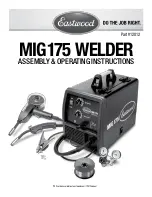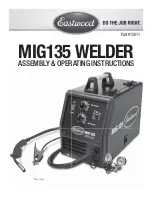
Quality
•
Reliability
•
Performance
Weldmatic 256
Model No CP124-3, Iss B 05/09
13
Quality
•
Reliability
•
Performance
7 Basic Welding Information
Choice of Shielding Gas
The choice of shielding gas is largely
determined by the consumable wire to
be used. Many proprietary shielding gas
mixtures are available.
The recommended shielding gases for use
with the Weldmatic 256 are:
• Mild Steel
Argon +
5 to 25% Carbon Dioxide;
100% CO
2
• Aluminium
Argon
• Stainless Steel Argon + 1 to 2% Oxygen.
Consult your gas supplier if more specific
information is required.
Shielding Gas Flow Rate
In G.M.A. welding, one function of the
shielding gas is to protect the molten weld
pool from the effects of oxygen in the
atmosphere. Without this protection the
weld deposit becomes ‘honeycombed’ in
appearance, an effect which is described as
weld porosity.
In draft-free conditions the gas flow rate
required to give adequate protection is
typically 10-12 litres/min. In situations
where drafts cannot be avoided, it may
be necessary to increase this rate up to
20 litres/min, and/or to provide screening of
the work area.
Weld porosity can also be caused by air
entering the gas stream through a damaged
hose, loose gas connection, or from
restriction in the nozzle, such as from excess
build-up of spatter.
When welding aluminium, particular care
must be taken with all aspects of shielding
gas delivery and workpiece preparation in
order to avoid weld porosity.
Establishing a Weld Setting
Once the consumable wire type, wire size
and shielding gas have been chosen, the two
variables that are adjusted in order to obtain
a the desired weld setting are;
• Wirefeed speed,
• Welding arc voltage.
The wirefeed speed determines the welding
current; increasing the speed increases the
current, and decreasing it decreases current.
The selected wirefeed speed must be
matched with sufficient arc voltage; a speed
increase requires an increase of arc voltage.
If the voltage is too low the wire will stub
and stutter, and there will not be a steady
arc. If the voltage is too high the arc will
be long with metal transfer occurring as a
series of large droplets.
Important:
Do not operate the Voltage
Control switch during welding.
The weld setting should be chosen to suit
the application and the thickness of the
metal to be welded. It is important to check
that the deposited weld provides sufficient
strength to suit the application.
A “good” weld will have the characteristics
illustrated in Figure 7. The weld has
penetrated into the parent metal, fusing the
root of the joint where the two plates meet,
and the weld blends smoothly into the side
walls.
A “bad” weld is shown in Figure 8. The weld
has not penetrated the joint root, and there
is poor side wall fusion. This lack of fusion
would normally be corrected by increasing
the arc voltage, or by increasing both
wirefeed speed and arc voltage to achieve a
higher current weld setting.
Содержание Weldmatic 256
Страница 32: ......
















































